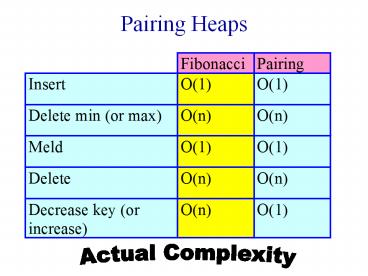Pairing Heaps - PowerPoint PPT Presentation
1 / 31
Title:
Pairing Heaps
Description:
Title: Data Representation Methods Author: Preferred Customer Last modified by: sahni Created Date: 6/17/1995 11:31:02 PM Document presentation format – PowerPoint PPT presentation
Number of Views:301
Avg rating:3.0/5.0
Title: Pairing Heaps
1
Pairing Heaps
2
Pairing Heaps
Amortized Complexity
3
Pairing Heaps
- Experimental results suggest that pairing heaps
are actually faster than Fibonacci heaps. - Simpler to implement.
- Smaller runtime overheads.
- Less space per node.
4
Definition
- A min (max) pairing heap is a min (max) tree in
which operations are done in a specified manner.
5
Node Structure
- Child
- Pointer to first node of children list.
- Left and Right Sibling
- Used for doubly linked linked list (not circular)
of siblings. - Left pointer of first node is to parent.
- x is first node in list iff x.left.child x.
- Data
- Note No Parent, Degree, or ChildCut fields.
6
Meld Max Pairing Heap
- Compare-Link Operation
- Compare roots.
- Tree with smaller root becomes leftmost subtree.
- Actual cost O(1).
7
Insert
- Create 1-element max tree with new item and meld
with existing max pairing heap.
insert(2)
8
Insert
- Create 1-element max tree with new item and meld
with existing max pairing heap.
insert(14)
- Actual cost O(1).
9
Worst-Case Degree
- Insert 9, 8, 7, , 1, in this order.
- Worst-case degree n 1.
10
Worst-Case Height
- Insert 1, 2, 3, , n, in this order.
- Worst-case height n.
11
IncreaseKey(theNode, theAmount)
- Since nodes do not have parent fields, we cannot
easily check whether the key in theNode becomes
larger than that in its parent. - So, detach theNode from sibling doubly-linked
list and meld.
12
IncreaseKey(theNode, theAmount)
If theNode is not the root, remove subtree rooted
at theNode from its sibling list.
13
IncreaseKey(theNode, theAmount)
9
18
6
2
2
3
1
3
Meld subtree with remaining tree.
14
IncreaseKey(theNode, theAmount)
18
2
3
3
- Actual cost O(1).
15
Delete Max
- If empty gt fail.
- Otherwise, remove tree root and meld subtrees
into a single max tree. - How to meld subtrees?
- Good way gt O(log n) amortized complexity for
remove max. - Bad way gt O(n) amortized complexity.
16
Bad Way To Meld Subtrees
- currentTree first subtree.
- for (each of the remaining trees)
- currentTree compareLink(currentTree,
-
nextTree)
17
Example
- Delete max.
- Meld into one tree.
18
Example
- Actual cost of insert is 1.
- Actual cost of delete max is degree of root.
- n/2 inserts (9, 7, 5, 3, 1, 2, 4, 6, 8) followed
by n/2 delete maxs. - Cost of inserts is n/2.
- Cost of delete maxs is 1 2 n/2 1
Q(n2). - If amortized cost of an insert is O(1), amortized
cost of a delete max must be Q(n).
19
Good Ways To Meld Subtrees
- Two-pass scheme.
- Multipass scheme.
- Both have same asymptotic complexity.
- Two-pass scheme gives better observed performance.
20
Two-Pass Scheme
- Pass 1.
- Examine subtrees from left to right.
- Meld pairs of subtrees, reducing the number of
subtrees to half the original number. - If subtrees was odd, meld remaining original
subtree with last newly generated subtree. - Pass 2.
- Start with rightmost subtree of Pass 1. Call this
the working tree. - Meld remaining subtrees, one at a time, from
right to left, into the working tree.
21
Two-Pass Scheme Example
Pass 1
22
Two-Pass Scheme Example
Pass 2
23
Multipass Scheme
- Place the subtrees into a FIFO queue.
- Repeat until 1 tree remains.
- Remove 2 subtrees from the queue.
- Meld them.
- Put the resulting tree onto the queue.
24
Multipass Scheme Example
25
Multipass Scheme--Example
26
Multipass Scheme--Example
- Actual cost O(n).
27
Delete Nonroot Element
- Remove theNode from its sibling list.
- Meld children of theNode using either 2-pass or
multipass scheme. - Meld resulting tree with whats left of original
tree.
28
Delete(theNode)
Remove theNode from its doubly-linked sibling
list.
29
Delete(theNode)
9
6
2
6
4
1
1
4
5
2
3
2
3
4
3
1
Meld children of theNode.
30
Delete(theNode)
9
6
2
6
1
1
4
5
3
2
3
4
2
3
1
Meld with whats left of original tree.
31
Delete(theNode)
9
6
2
3
6
2
3
1
1
4
5
2
3
4
- Actual cost O(n).
1

